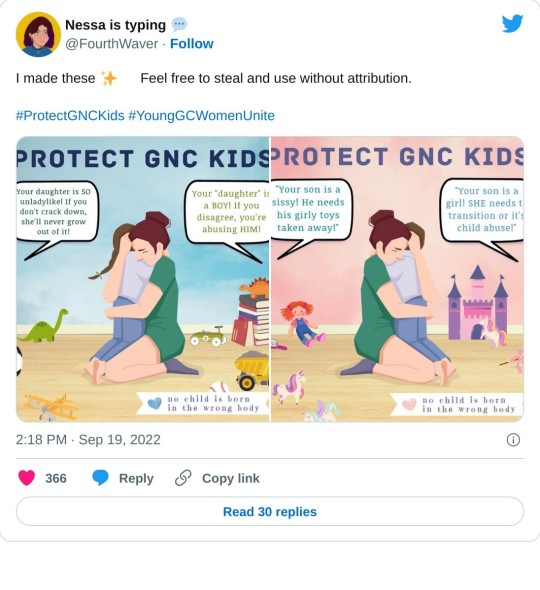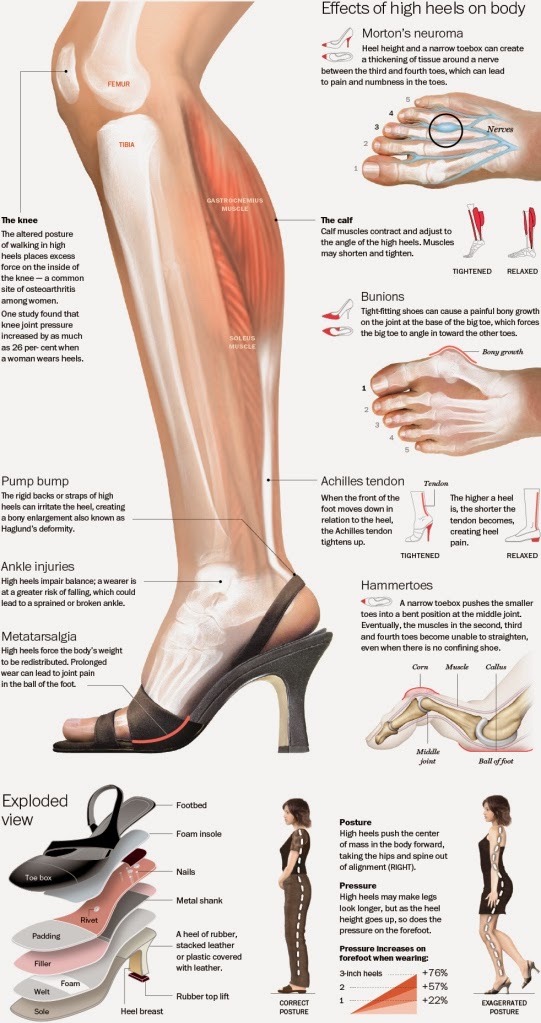Text

and this is why i 1. never share my social media in professional settings and 2. only post on tumblr
375 notes
·
View notes
Text

A butch (almost)) every day ▪️20/04/2024
She's reading a good book:)
634 notes
·
View notes
Text

If you are 29 and have been trying to have kids long enough to have exhausted fertility treatment options you didn’t by any reasonable definition “wait” to try for kids
977 notes
·
View notes
Text
Went to a small gathering today and several of the women wore shorts and had completely unshaven leg hair. The event wasn't at all feminism related or even women-exclusive, and it wasn't only women from one friend circle but from several completely non-overlapping ones.
Nature is healing 😌
387 notes
·
View notes
Text
my flabber is gasted and my gob has been smacked
21K notes
·
View notes
Text

If you've got a Twitter pls show her some love 💕
These are amazing!


4K notes
·
View notes
Text
Why I Stopped Believing in Male Supremacy- Extended: Fitness Edition
Recently I made a list of reasons I outgrew the myth of female inferiority (which has since been removed by staff). A handful of people have expressed interest in more thorough elaborations as well as sources. I will be replying to this feedback and explaining how I came to the contested fitness claims specifically.
Modern conceptions of the limits of female strength are restricted.
The first piece of supporting evidence for this is a study in which the bones of modern female athletes are compared to those from a number of women who lived between ~5300 BC and 850 AD. The researchers measured strength differences between the groups by looking at humeral and tibial cross-sectional rigidity, shape, and interlimb loading. The modern athletes studied are considered semi-elite and are mutually exclusive participants of rowing, running, and (European) football.

“The Neolithic women analysed in the study (from 7400-7000 years ago) had similar leg bone strength to modern rowers, but their arm bones were 11-16% stronger for their size than the rowers, and almost 30% stronger than typical Cambridge students.” (X)
“The loading of the upper limbs was even more dominant in the study’s Bronze Age women (from 4300-3500 years ago), who had 9-13% stronger arm bones than the rowers but 12% weaker leg bones.” (X)
The data from the subjects who lived between ~5300 BC and 850 AD reflects the average woman from those times whereas the modern athletes presumably represent some of today’s most specialized specimens. Modern athletes are not constricted by survival-centered lifestyles, rather able to intentionally and strategically work towards fitness. With this in mind, the gap between rowers, who possess the strongest arms out of the modern athletes, and Neolithic women is curious.
Behavioral variation is cited as the determining factor for differences in strength.
A conservative conclusion to draw is that modern women are not expanding what is known to be women’s biological capacity for fitness as previously unrecorded women from past millennia surpass current elite athletes in some measures of strength.
2. The cultural suppression of female body fat artificially inflates the sexually dimorphic muscle disparity.
Essential fat is the fat needed for your body to function normally and differs from stored fat. The predominant factor determining an individual’s essential fat percentage is sex. Women should not maintain less than 10-13% body fat, whereas men should not maintain less than 2-5% body fat.
While the numbers vary slightly from source to source, the following standards from the American Journal of Clinical Nutrition are well agreed upon:
For people aged 20 to 39, women should aim for 21% to 32% of body fat. Men should have 8% to 19%.
For people 40 to 59, women should fall between 23% to 33% and men should fall around 11% to 21%.
If you’re aged 60 to 79, women should have 24% to 35% body fat and men should have 13% to 24%.
This is significant as a 25 year old woman with 26% body fat would be considered of average health, yet a man of the same age and body fat percentage would be considered obese.
The role of fat in muscle building is best demonstrated with bulking and cutting. Bulking and cutting are phases in muscle growth commonly used among people who frequent the gym or participate in bodybuilding. Bulking refers to the growth stage where calorie consumption exceeds your body’s maintenance needs. This promotes muscle growth as well as increases body fat. It is significantly harder to increase muscle mass without this. Cutting is the fat loss stage where calorie intake is decreased below your body’s maintenance needs in order to deplete the fat preserves built up during bulking, thus giving your body more definition. This is largely motivated by aesthetic desire and not a necessary second step.
In light of the aforementioned data, it is clear that the cultural standards regarding women’s body fat do not reflect what is physiologically appropriate. The psychological pressure to stay thin subjugates many women to maintaining a lower than average body fat percentage. By refraining from consistently engaging in a caloric surplus for any sustained period, women do not enter the phase where muscle gain is more easily accomplished.
All of this is to say that the promotion of women’s fat gain is not akin to advocating for women to surpass male weight gain and enter the range of obesity, but to catch up as women naturally maintain more fat and thus cannot not be compared to men with standardized percentages or pounds.
If you are familiar with obesity rates, the points above may seem irrevelant as women and men are overweight at similar rates, so how could fat differences impact the muscle disparity?
One answer lies in the long term health effects of eating disorders. This is to say that even after weight is regained, young women–the population most afflicted by eating disorders–may be permanently affected. Particularly your hormonal, heart, brain, and bone health are at risk.
A related point is that exercise is easiest when you are young. Young women and girls are largely discouraged from it and these behavioral habits persist throughout life. X. Even if habits are changed, new research has discovered lifelong benefits of childhood exercise, including for inactive adults.
Both a lack of propensity to move and the rates of disordered eating are compounded by constant psychological attacks on the female form by male media. This has greatly increased as the public sphere has shifted into a digital world. Data supports the idea that young women and girls are most targeted by ‘beauty’ culture conditioning with female obesity rates rapidly increasing only after the age of 30.
All of this is suggest that we are losing the battle early–and our athletes are far from unscathed:
One survey of female college athletes found that 68% reported pressure to be pretty and 30% said they were afraid of becoming too muscular. (X)
Nearly half of female athletes – 45% – particularly in sports where a lean body is considered important, have disordered eating or an eating disorder. (X)
Another source reported the following:
35% of female college athletes struggle with anorexia
Disordered eating impacts 62% of female athletes
Athletes who struggle with disordered eating are 8 times more likely to be injured
58% of female college athletes meet criteria for bulimia
No one can reasonably argue that modern female athletes reflect women’s potential in light of these numbers. They are likely even higher as this topic largely relies on self-reporting and carries a significant cultural taboo.
Fat and exercise need to be most encouraged in younger women and girls. Phsyical development is not completed until the age of 30. This means managing your health matters most during these years.
An interesting sidenote to help put an end to fat fearmongering is that we have reason to believe that fat may not even be antithetical to athleticism in the first place.
All of this ties back to the first point–Modern conceptions of the limits of female strength are restricted. To take it one step further, I would argue all women have been restricted psychologically, physically, or medically in a way that affects their physical fitness by the age of 30.
For example, millions of women have used an oral contraceptive pill. Oral contraceptives have been found to greatly affect fitness. In fact, women who don’t take the pill, gain about 60% more muscle than their drugged counterparts. Another study found that the potency of estradiol in oral contraceptives correlated directly to muscle hypertrophy alone, meaning that women taking it did see an increase in their muscle size, but without an increase in strength.
It doesn’t stop there, however, medicine harming women is too deep of a rabbit hole for this thread for various reasons.
Let’s talk about how women are being poisoned.
56% of foundations, 48% of lip products and 47% of mascaras were found to contain high levels of fluorine, which is an indicator of PFAS. All of these cosmetics are applied around the eyes and mouth which face potential absorption through the skin or tear duct, as well as inhalation and ingestion. (ABC News)
“A smart consumer would read the label and avoid it, it is not possible to do that, it is not on the label.”
PFAS is a ‘forever chemical’ meaning it does not naturally degrade. Because of its longevity, it can contaminate groundwater for decades. The chemical has been linked to kidney cancer, hypertension, thyroid disease, low birth weight and immunotoxicity.
While the numbers vary, most sources peg the amount of women who wear makeup between 77-90%. If you are familiar with cosmetic practices, you will know that women most commonly own a combination of products. This would suggest that even though high levels of fluorine are in half of all common beauty products, likely more than half of those 77-90% of women own at least one of those contaminated products. The extent is unknown.
While the implications of all of this deserve attention, this data does directly relate to fitness so let’s circle back around to the phsyical ailments mentioned above, starting with thyroid disease. Among other symptoms, thyroid issues are associated with muscle weakness and fatigue. Hypertension, or high blood pressure, is characterized by shortness of breath, lightheadedness, fatigue, and heart palpitations. Immunotoxicity is an adverse effect on the immune system and thus overall health. When studies suggest most women may be disproportionately burdened by such conditions, there is to room to ask “What if”. What if most women were never exposed to toxins? What if the contamination wasn’t focalized around sensitive areas of our body? What if the age at which girls are indoctrinated into beauty culture continues to lower?
Our clothing is our enemy too.
Did you know that high heels cause a great deal of stress on your body?

The American Podiatric Medical Association found that 72% of women wear high-heeled shoes (39% wear heels daily, while 33% wear them less often). 59% report toe pain as a result of wearing uncomfortable shoes; 54% report pain in the ball of the foot. But that is from an article published in 2009 and we have since seen an even more strict resurgence of femininity.
One article writes “Bras Linked to Minor Health Problems”:
“Research suggests [bras] can cause breathing, skin and circulation problems; back pain; and even digestive disorders.”
That may not surprise you, but did you know that athletes are even more at risk?
“Sports bras are also dangerous if worn too often or for too long. The pressure used to hold the breasts in place while exercising can constrict the rib cage and cause breathing difficulties and circulation problems. This is especially dangerous because during exercise, one breathes deeply more often and blood circulates faster than when resting or pursuing normal activities.”
You do not need a bra. Search up if you do and you will be bombarded by misogynistic propaganda shaming “saggy breasts”. Bras are a modern invention. They are estimated to date back at the earliest to ancient Greece. Two thousand years is a mere blip in the span of human evolution.
One long term french study of women ages 18-35 found that bras actually cause breasts to sag as well as prevent muscle growth: (Source)
“Women who did not wear bras had a 7 millimeter lift as measured from their nipples each year. Their breasts were also firmer, and their stretch marks faded. There was also no evidence that the bras helped get rid of back pain.”
“The researchers believed that wearing bras prevented the growth of breast tissue, which lead to deterioration of the muscles that support the breasts. If you don’t wear a bra, the muscles are worked-out more, the findings suggest.”
Recent findings have brought more bad news about bras:
New testing on a variety of popular branded sports bras and athletic wear has revealed high levels of BPA, a chemical compound that’s used to make certain types of plastic and can lead to harmful health effects such as asthma, cardiovascular disease and obesity. (CNN)
Going back to the cultural/societal sector:
Hobbies and lifestyles are also passed down from mother to daughter and father to son. Even in the 1960s, American girls were barred from sports. Their schools simply did not have sports teams they were allowed on, except for the rare school which featured volleyball.
The cultural value we give to male sports also creates an environment very different for boys than that in which girls grow up when winning female soccer teams weren’t even paid as much as losing male teams until this year (2022).
This graphic highlights the disparity in viewing women’s sports:

X
It doesn’t stop there:
The underlying research that makes good nutrition and effective training possible has also all been done on men, says exercise physiologist and nutrition scientist Stacy Sims in her TEDxTauranga Talk. “[During my early research I was told] ‘women are an anomaly, so we don’t necessarily study women in sport nutrition or exercise science’… I looked around and I thought surely with 50 percent or more of the population being female, aren’t the men the anomaly and they don’t know it yet?”
Sports as we know them today were also created by men, for men, at a time when men subjugated women to the domestic sphere thus they accentuate male strengths.
In total, female athletes face an overwhelming amount of handicaps mentally, phsyically, and systemically which are flat out not imposed onto their male peers. We simply do not know how strong women can be. I’m tired of hearing patriarchal lies of “female limits” which we are bullied into accepting under the guise of “rationality” when there is so much evidence to the contrary. Female oppression artifically inflates any sexually dimorphic strength disparity. Do not let unprovable beliefs about the extent of sexual dimorphism discourage you from fitness. No studies unaffected by the factors mentioned above exist in part because you cannot kidnap human babies and raise them for 20 years inside a facility closed to the outside world without any adults who will still propagate the social construct of gender. Some of the factors such as disparity in nutrition information will take years to overcome, if it ever happens. Every nutrition label is still labeled with the recommended male dietary percentages only. Science and studies are not a reflection of objective truths. They reflect our current world with a few controlled variables and that is it. At the end of the day, we have enough pieces of evidence, such as prehistoric big game hunters being 30-50% female, to remain suspiscious of claims of female weakness. Mammoths did not choose to die at the hands of both female and male hunters because of affirmative action. Despite this noncomprehensive breakdown of culturally imposed obstacles to female health and fitness, women currently do exceed male limits of athleticism in a number of ways, however because of how long this is getting, it will be a separate post.
1K notes
·
View notes
Note
have you read ‘kim ji-young, born 1982’ ?
i just watched the movie based on it and i can’t stop crying. I read that this book was what launched the 4B movement in korea. So i wanted to see it because it takes a lot to radicalize the average woman. No matter how much evil men do, the average woman tries to believe in men’s humanity. So the fact that this book alone radicalised so many women made me think it had to be phenomenal. And it was. I cried a lot. I think every woman should watch it before getting married. There’s no words to explain this movie. It’s painful to watch because it’s relatable but i think every girl should watch it so she doesn’t fall into men’s trap.
No, I haven't read it. Sharing your message for other feminists!
406 notes
·
View notes
Text
It's been a very long, exhausting day for Ruckus so far




999 notes
·
View notes
Text
The rise in attention to the South Korean 4B movement these last couple days is so thrilling. I see so many women talking about it on tiktok, entire comment sections flooding with “4B movement now” whenever a woman complains about her shitty moid of a partner, coupled with detailed chroniclings of the ever-decaying state of the male loneliness epidemic.
1K notes
·
View notes
Text
217 notes
·
View notes






